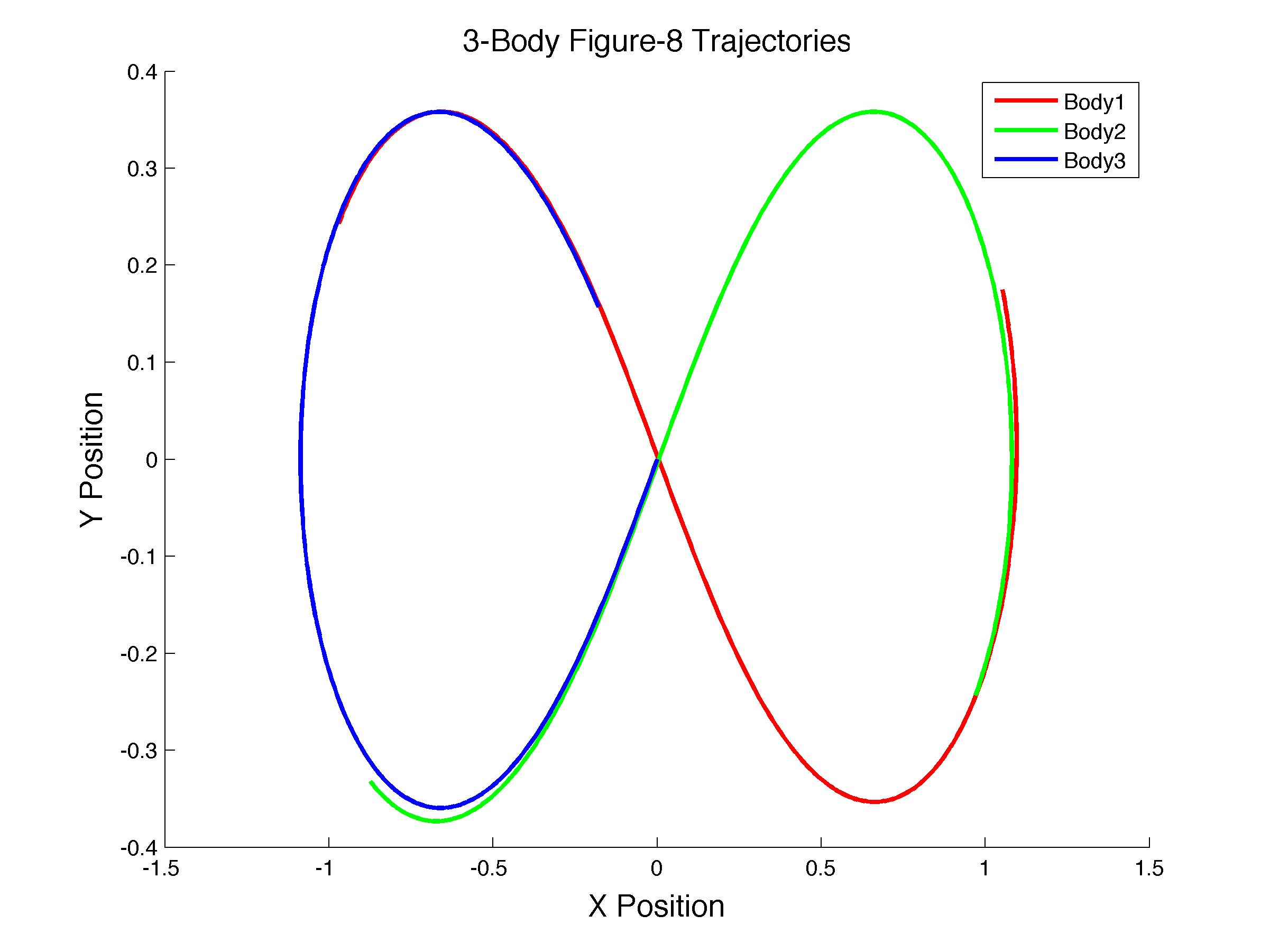I am in a begginers programming course and we got a little project. I chose to simulate the three body problem using the Euler method. Even though the system is chaotic there are some special cases which produce symmetric trajectories. I get most of them, but the most important one doesn't come out. It's called figure 8 and supposed to be stable.
I'm sure that the initial conditions are fine. And the program should be as well, as I get the other expected results. So the question is whether there is an error in my program or the Euler method doesn't work for this specific case. (I would then change to the Runge-Kutta method)
I appreciate any kind of help!
#include <iostream>
#include <cmath>
#include <fstream>
using namespace std;
double const ms=1.0000000000000000;
double const me=1.0000000000000000;
double const mm=1.0000000000000000;
double const G=1.000000000000000000;
double const dt=0.0001000000000000;
/* 1=Sonne,2=Erde, 3=Mond */
double fsx(double x1, double y1, double x2, double y2, double x3, double y3){
double dv;
dv=G*(me/((y2-y1)*(y2-y1)+(x2-x1)*(x2-x1)))*((x2-x1)/sqrt((y2-y1)*(y2-y1)+(x2-x1)*(x2-x1)))+G*(mm/((y3-y1)*(y3-y1)+(x3-x1)*(x3-x1)))*((x3-x1)/sqrt((y3-y1)*(y3-y1)+(x3-x1)*(x3-x1)));
/*Projektion der Gravitationskraft auf Körper 1 auf x-Richtung */
return dv;
}
double fsy(double x1, double y1, double x2, double y2, double x3, double y3){
double dv=G*(me/((y2-y1)*(y2-y1)+(x2-x1)*(x2-x1)))*((y2-y1)/sqrt((y2-y1)*(y2-y1)+(x2-x1)*(x2-x1)))+G*(mm/((y3-y1)*(y3-y1)+(x3-x1)*(x3-x1)))*((y3-y1)/sqrt((y3-y1)*(y3-y1)+(x3-x1)*(x3-x1))); /*Projektion der Gravitationskraft auf Körper 1 auf y-Richtung */
return dv;
}
double fex(double x1, double y1, double x2, double y2, double x3, double y3){
double dv;
dv=G*(ms/((y2-y1)*(y2-y1)+(x2-x1)*(x2-x1)))*((x2-x1)/sqrt((y2-y1)*(y2-y1)+(x2-x1)*(x2-x1)))+G*(mm/((y3-y1)*(y3-y1)+(x3-x1)*(x3-x1)))*((x3-x1)/sqrt((y3-y1)*(y3-y1)+(x3-x1)*(x3-x1)));
/*Projektion der Gravitationskraft auf Körper 1 auf x-Richtung */
return dv;
}
double fey(double x1, double y1, double x2, double y2, double x3, double y3){
double dv=G*(ms/((y2-y1)*(y2-y1)+(x2-x1)*(x2-x1)))*((y2-y1)/sqrt((y2-y1)*(y2-y1)+(x2-x1)*(x2-x1)))+G*(mm/((y3-y1)*(y3-y1)+(x3-x1)*(x3-x1)))*((y3-y1)/sqrt((y3-y1)*(y3-y1)+(x3-x1)*(x3-x1))); /*Projektion der Gravitationskraft auf Körper 1 auf y-Richtung */
return dv;
}
double fmx(double x1, double y1, double x2, double y2, double x3, double y3){
double dv;
dv=G*(me/((y2-y1)*(y2-y1)+(x2-x1)*(x2-x1)))*((x2-x1)/sqrt((y2-y1)*(y2-y1)+(x2-x1)*(x2-x1)))+G*(ms/((y3-y1)*(y3-y1)+(x3-x1)*(x3-x1)))*((x3-x1)/sqrt((y2-y1)*(y2-y1)+(x2-x1)*(x2-x1)));
/*Projektion der Gravitationskraft auf Körper 1 auf x-Richtung */
return dv;
}
double fmy(double x1, double y1, double x2, double y2, double x3, double y3){
double dv=G*(me/((y2-y1)*(y2-y1)+(x2-x1)*(x2-x1)))*((y2-y1)/sqrt((y2-y1)*(y2-y1)+(x2-x1)*(x2-x1)))+G*(ms/((y3-y1)*(y3-y1)+(x3-x1)*(x3-x1)))*((y3-y1)/sqrt((y3-y1)*(y3-y1)+(x3-x1)*(x3-x1))); /*Projektion der Gravitationskraft auf Körper 1 auf y-Richtung */
return dv;
}
double euler(double (f)(double,double,double,double,double,double), double x1, double y1, double x2, double y2, double x3, double y3, double vi){
double vf=vi + f(x1, y1, x2, y2, x3, y3)*(dt);
return vf;
}
int main() {
float xf3, yf3, tmax;
ofstream out("project1.dat");
ti=0.00000000000000000, xi1=-0.97000436, yi1=0.24308753, vxi1=0.466203685, vyi1=0.43236573, tmax=3.000000000000, xi2=-xi1, vxi2=vxi1, yi2=-yi1, vyi2=vyi1, xi3=0.0000000000000, vxi3=-2*vxi1, yi3=0.0000000000000000, vyi3=-2*vyi1;
for(tf=0.0;tf<=tmax;tf=tf+dt){
vxf1=euler(fsx,xi1,yi1,xi2,yi2,xi3,yi3,vxi1);
vyf1=euler(fsy,xi1,yi1,xi2,yi2,xi3,yi3,vyi1);
vxf2=euler(fex,xi2,yi2,xi1,yi1,xi3,yi3,vxi2); /* Gravitationskraft und damit auch fx und fy sind symmetrisch -> es reichen 2 Funktionen */
vyf2=euler(fey,xi2,yi2,xi1,yi1,xi3,yi3,vyi2);
vxf3=euler(fmx,xi3,yi3,xi2,yi2,xi1,yi1,vxi3);
vyf3=euler(fmy,xi3,yi3,xi2,yi2,xi1,yi1,vyi3);
xf1=xi1+(vxf1)*(dt);
yf1=yi1+(vyf1)*(dt);
xf2=xi2+(vxf2)*(dt);
yf2=yi2+(vyf2)*(dt);
xf3=xi3+(vxf3)*(dt);
yf3=yi3+(vyf3)*(dt);
out << tf << " "<< xf1 << " " << yf1 <<" "<< vxf1 << " " << vyf1<< " "<< xf2 << " " << yf2 <<" "<< vxf2 << " " << vyf2<< " "<< xf3 << " " << yf3 <<" "<< vxf3 << " " << vyf3 << endl;
ti=tf;
vxi1=vxf1;
vyi1=vyf1;
vxi2=vxf2;
vyi2=vyf2;
vxi3=vxf3;
vyi3=vyf3;
xi1=xf1;
yi1=yf1;
xi2=xf2;
yi2=yf2;
xi3=xf3;
yi3=yf3;
}
out.close();
}

